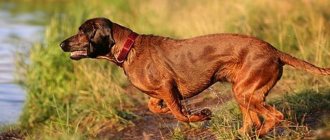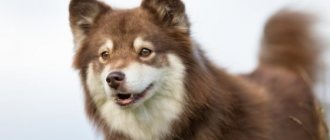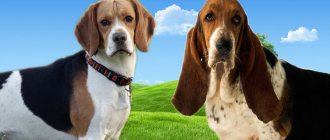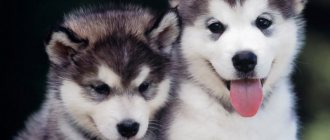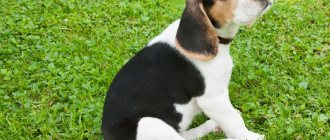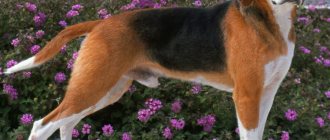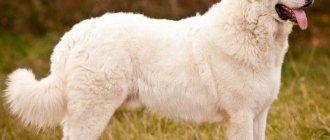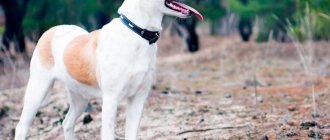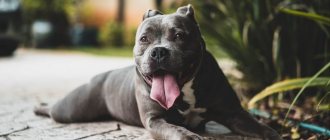/ Dogs / Dog breeds / Finnish hound dog breed
0
2034
Article rating
The Finnish Hound is a versatile hunting dog. It is used to hunt small animals such as hare, fox or badger. But it is also capable of tracking animals such as a wolf, bear, elk or deer. The Finnish Hound has a calm and independent character, but is not recommended for inexperienced owners. These animals need space and intense physical activity, so keeping it in a city apartment is not recommended.
Finnish hound
History of the Finnish Hound breed
There are no exact facts about the origin of the Finnish hound. The first mention dates back to 1850. It is believed that this dog combines the best qualities of hound breeds, and possibly the English Foxhound. But it is reliably known that the jeweler Tammelin, who lived in the Finnish city of Pori, began the selection of this breed in 1870, ensuring that only the best working qualities were preserved in the offspring (which, however, he succeeded very well). Appearance was not given much attention, but in 1932 the Finnish Kennel Club established a tricolor color. The International Canine Association recognized the breed in 1954.
Today the breed is not so numerous, since hunting is not an important human activity. But these dogs excel in sports competitions, so they still have fans.
65 years have passed since the Finnish Hound was recognized by the FCI
In Russia it is difficult to find a Finnish hound, but in Norway, Denmark, and Sweden they are preferred over other hound breeds.
In the homeland of the breed, its name sounds like Suomenajokoira.
Rules of care
The Finnish Hound is not too demanding in terms of grooming. The main requirement is careful monitoring of the condition of the ears. Regular ear hygiene will help avoid problems with otitis media.
Brush your pet's coat weekly or as needed using a stiff brush. This procedure is needed to remove dead hair, dirt and dust.
The dog is rarely bathed. For minor stains, it is enough to wipe its fur with a damp terry cloth.
After walking in the forest belt, carefully examine the animal’s ears, paw pads and fur. Then, if you find cuts and attached ticks, you can immediately take action.
Keep in mind that during the hunting season, the Finnish hound often comes into contact with wild animals that carry dangerous diseases. Regular and timely vaccination of your dog is your responsibility.
Description of the breed
The current breed standard was published on July 17, 1997. According to the FCI classification, the Finnish Hound belongs to group 6 (“Hounds, Bloodhounds and Related Breeds”), section 1.2 (“Medium-sized Hounds”). When evaluating a dog, a test of working qualities is mandatory.
External qualities of the Finnish hound
The standard describes the Finnish hound as a strong, tri-colored dog, rather tall-legged, with an elongated body. The chest of the representatives is very wide, which is due to the loud barking during the rutting season (a lot of air is required, the lungs expand and form a wide chest).
The standard contains an image of the ideal representative of the breed
Gender differences are clearly expressed: males are taller and more powerful than females.
Basic appearance parameters:
- The skull is wide, domed. The groove between the eyes is barely noticeable; the brow ridges and the occipital protuberance are clearly defined. The stop is not sharp, but noticeable.
- The nose is black with large mobile nostrils.
- The jaw is strong and has a scissor bite.
- The eyes are medium in size, almost oval in shape, dark brown in color. The expression is attentive, calm.
- The ears are hanging, high-set, flat, and when pulled forward they extend beyond half the muzzle.
- The body is muscular, the stomach is slightly tucked.
- The tail is set low, slightly curved, reaching the hocks. Thick at the base, tapering towards the end. Usually carried down, but when running it can rise without crossing the topline.
- Limbs straight and parallel. Paws are oval, with narrow toes gathered. Claws and pads are preferably black.
- The movements are light, sweeping, the limbs move parallel to each other.
- The coat is medium length, straight, lying close to the body. The undercoat is short and dense.
- The color is tricolor: dark red on the head, limbs, shoulders, lower chest;
- black saddle on the back;
- white on head, neck, throat, front of chest, lower limbs, end of tail.
- males - from 55 cm to 61 cm (ideal height - from 57 to 59 cm);
Character and temperament
According to the standard, the Finnish Hound is a calm, energetic and friendly dog that never shows aggression. She definitely needs human company. Deprived of it, the dog may become indifferent to its surroundings or, conversely, nervous. Usually the Finnish hound is used for its intended purpose and is not kept at home, but those who have acquired this pet as a companion note its calm behavior and friendly attitude towards all family members.
The main purpose of the dog is to hunt, mainly foxes and hares, but this breed is called universal. She could drive wolves, deer, lynxes (which she did in ancient times, but now these types of hunting are prohibited). The dog follows the scent on its own and barks loudly, guiding the person. It can work even in difficult conditions, but only in the warm season. During work, he shows amazing endurance and activity.
It is not recommended to use the Finnish hound as a watchdog. Her innate friendliness will not allow her to perform this function. It is necessary to carry out early socialization of the pet so that it is not afraid of strangers and relatives.
Small domestic animals will always be under threat if a family gets such a pet. This applies even to those cats with whom the puppy grew up. Hunting instincts turn out to be stronger than even many years of proximity.
Disadvantages and defects of the breed
All deviations from standard characteristics are deficiencies, but they are assessed in accordance with their severity and impact on the health and performance of the dog.
So, the disadvantages include:
- too light or heavy type of build;
- triangular head;
- folds on the skin;
- narrow or short muzzle;
- direct bite or slight underbite;
- short and soft wool;
- mottled color or blurred color boundaries;
- height 1 cm higher or lower than specified in the standard;
- Behavior with other dogs is cowardly or defiantly pugnacious.
Vices that become grounds for disqualification include:
- aggressiveness or cowardice;
- depigmentation of the nose;
- obvious overshot or undershot;
- curled tail;
- height exceeding or lower than specified in the standard by more than 1 cm.
Video: Finnish hound breed
Description
The appearance of the Finnish hound is typical for representatives of this species. A strong, lean body, well-developed muscles - all this ensures a confident drive of game even on very rough terrain.
A small head with strong jaws, a large black nose and almond-shaped eyes is crowned with drooping ears covered with long hair.
The look of Finnish hounds is very expressive, immediately interested in everything that is happening around them.
The tail is usually not very long and has the shape of a saber.
The coat is short and very dense, with a thick undercoat, which protects the dog from both frost and moisture.
Training rules
The Finnish hound must be trained to interact with the owner both during the hunt and outside of it. It will be easiest to train a puppy from working parents, but even if this is not the case, you should not despair. Training should begin as early as possible and it is better if you have the help of a specialist.
Finnish hound needs training in hunting skills
The main things you should teach your puppy:
- Come to the owner's call immediately upon hearing the nickname. This is achieved by training during eating, when the puppy is allowed to eat only on the condition that he appears immediately after the call. When the reaction to the name is worked out, the puppy is taught to react in the same way to the sound of the horn.
- Find the owner. To do this, the puppy must navigate by smell and trail both on the plain and in the forest zone. The skill is practiced at special training grounds.
- Keep track without getting distracted or switching to other smells.
- Give a voice when detecting tracks and prey, as well as during the entire period of rutting after it. Silent individuals among hounds are removed from breeding.
Care and maintenance
Any hound needs to be active every day. This is not only her job, but also a necessity, without which the hound develops stress. If the dog is not used for hunting, it should engage in sports exercises or simply receive intense exercise by running a lot (for example, accompanying the owner on a bike ride).
The Finnish Hound needs intense daily exercise.
The most suitable conditions for keeping are a private house with a large yard. It is allowed to keep a Finnish hound in an apartment, but walks should be long, at least 2 times a day for 2 hours, and preferably active.
Also, when starting a Finnish hound, the owner must take into account its “talkativeness”. This dog is very vocal, so if you keep it in an apartment, you cannot avoid complaints from neighbors.
Finnish hounds are sociable, so it is recommended to walk them with other dogs if possible. But you should not let him off the leash in places not equipped for walking - the hunting instincts are too strong, the dog can run far, get lost or get hit by a car.
Otherwise, caring for the Finnish hound is simple:
- Once a week, the pet's fur is cleaned with a rubber mitten to remove dead hair, dust, and dirt particles. During shedding, it is better to use a stiff brush.
- Bathing is rare, 2–3 times a year. In other cases, contaminated wool is simply wiped with a damp cloth.
- Eyes are wiped daily.
- There is no need to trim the nails of working dogs; they are worn down while running over rough terrain.
- The ears are checked and cleaned 2-3 times a week, since the dog is active and the pinnae cover the ear canal. This breed often develops ear infections.
- After the hunt, the pet is carefully examined for scratches and other damage. Particular attention is paid to the paw pads.
Feeding your pet
Finnish hounds always have a good appetite. At the same time, they are ready to eat everything that is edible. Great news for owners, on the one hand. On the other hand, this is a direct path to excess weight in a pet if it does not receive sufficiently intense exercise. Therefore, the owner should pay special attention to feeding. It has two ways:
- natural diet;
- ready-made dry and wet food.
Based on the characteristics of the Finnish hound, the second option is preferable. When choosing industrial food, the owner can accurately dose the portions, following the recommendations on the packaging. It is only recommended to increase them a little if the dog is actively working. Since the hound needs complete protein, the food should be at least premium.
When choosing ready-made food, preference should be given to special products for active individuals:
- Royal Canin HE Club;
- Chicopee Pro Nature Line Active;
- Acana Heritage Sport & Agility;
Acana Heritage Light & Fit consists of free-range chicken, turkey, nest-laid eggs and wild-caught flounder
- Belcando Adult Active.
In the case of a natural diet, the menu must be developed together with a veterinarian. Portions should be nutritious and balanced in protein, fat and carbohydrates. Also in this case, it is necessary to introduce vitamin and mineral supplements into the diet.
Breed diseases
The average lifespan of a Finnish hound is 13–15 years. In general, these are strong and healthy dogs. Of the genetically transmitted diseases, Finnish hounds are characterized by:
- dysplasia of the elbow and hip joint - abnormal development of the articular head, which first leads to lameness and then immobility of the animal, is detected by genetic tests;
- Cerebellar ataxia is a dysfunction of this part of the brain, which leads to disproportionality in the animal’s movements; if the symptoms are not noticed in time, the dog ultimately dies;
- tendency to demodicosis - damage by subcutaneous mites.
Also, dogs of this breed often experience excess weight due to insufficient physical activity, which subsequently leads to diseases of the joints and cardiovascular system.
Choosing a puppy
In Russia, the Finnish hound is a rare breed, so if you want to get such a pet, you should establish contacts with foreign nurseries in Finland, Denmark, and Sweden. Considering the difficulties of transportation, a puppy will not cost less than 20 thousand rubles. And the offspring of working parents with an ideal pedigree are estimated at 30 thousand rubles.
Finnish hound puppies should be looked for in foreign nurseries
When choosing a puppy, you should focus on both external signs of health and the presence of a pedigree (for kids, this is a puppy card). The puppy should be friendly and inquisitive, and not shy away from people. It would be good to see his parents, they also should not be timid or aggressive. It is important that there are no “silent people” in the family.
It is better to choose a puppy at the age of 5 months, but rarely do any breeders keep babies up to that age. Then you can trust the eye of the owner, who has already noticed which of the litter has the best hunting qualities.
Character and training
For the most part, Finnish hounds have an easy-going, friendly and responsive character. Thanks to these qualities, representatives of the breed become excellent companions and sports partners. However, you should not think that the gentle nature of the Finnish Hound is the key to easy training.
With representatives of the breed you need to show persistence, perseverance, rigor and restraint. Representatives of the breed find it difficult to practice commands, especially calling. This happens because the Finnish Hound quickly becomes interested in playing or chasing. If there were working breeders in the puppy's family, you can be sure that the pet will rely more on its own opinion than on your orders.
During adolescence, the Finnish Hound may try to take a leadership position in the family, but these aspirations must be stopped. It is worth understanding that the leader of the pack is always noble and reserved, so shouting and punishment will not give you a good reputation. Regular training is boring for the breed, so training needs to be diluted with very energetic and long games.
Advice: stop the puppy’s desire to run in front of you - this is the unconscious first sign of dominance over the owner.
Adult Finnish hounds are stubborn when trained, so the dog should be trained from puppyhood. It is important to prioritize and find the right motivation. Representatives of the breed do not work for bribes; the reward must be truly valuable. It is for this reason that it is very important to pay enough attention to the puppy and establish a very close relationship with him.
